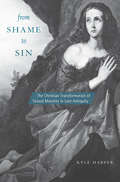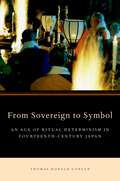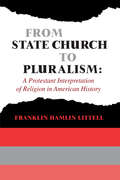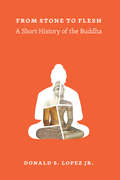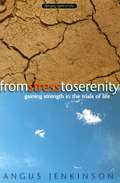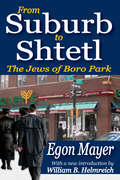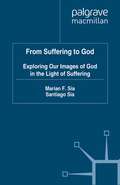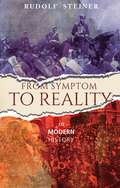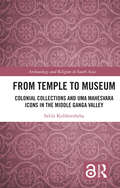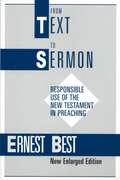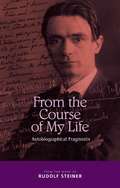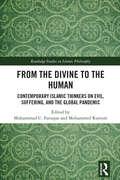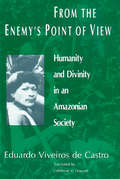- Table View
- List View
From Shame to Sin: The Christian Transformation Of Sexual Morality In Late Antiquity (Revealing Antiquity Ser. #20)
by Kyle HarperThe transformation of the Roman world from polytheistic to Christian is one of the most sweeping ideological changes of premodern history. At the center was sex. Kyle Harper examines how Christianity changed the ethics of sexual behavior from shame to sin, and shows how the roots of modern sexuality are grounded in an ancient religious revolution.
From Sovereign to Symbol: An Age of Ritual Determinism in Fourteenth Century Japan
by Thomas Donald ConlanFourteenth-century Japan witnessed a conflict about the nature of power that was expressed through the rituals and institutions of two rival courts. Ultimately, political authority came to be asserted through the language of esoteric Buddhist rituals, which determined the parameters of political possibility in Japan.
From State Church to Pluralism: A Protestant Interpretation of Religion in American History
by Franklin LittellFor most of our history, American religious life has been dominated by a view of church history in which we appear as mere deposits of European religious culture. In fact, however, the freedom of Americans to choose without penalty to join any religious body or none at all is new in human history. This book is an effort to understand and interpret how we arrived at our present situation and, in doing so, to clarify many cultural, social and political issues.
From State Church to Pluralism: A Protestant Interpretation of Religion in American History
by Franklin LittellFor most of our history, American religious life has been dominated by a view of church history in which we appear as mere deposits of European religious culture. In fact, however, the freedom of Americans to choose without penalty to join any religious body or none at all is new in human history. This book is an effort to understand and interpret how we arrived at our present situation and, in doing so, to clarify many cultural, social and political issues.
From Stone to Flesh: A Short History of the Buddha (Buddhism and Modernity)
by Donald S. Lopez Jr.We have come to admire Buddhism for being profound but accessible, as much a lifestyle as a religion. The credit for creating Buddhism goes to the Buddha, a figure widely respected across the Western world for his philosophical insight, his teachings of nonviolence, and his practice of meditation. But who was this Buddha, and how did he become the Buddha we know and love today? Leading historian of Buddhism Donald S. Lopez Jr. tells the story of how various idols carved in stone—variously named Beddou, Codam, Xaca, and Fo—became the man of flesh and blood that we know simply as the Buddha. He reveals that the positive view of the Buddha in Europe and America is rather recent, originating a little more than a hundred and fifty years ago. For centuries, the Buddha was condemned by Western writers as the most dangerous idol of the Orient. He was a demon, the murderer of his mother, a purveyor of idolatry. Lopez provides an engaging history of depictions of the Buddha from classical accounts and medieval stories to the testimonies of European travelers, diplomats, soldiers, and missionaries. He shows that centuries of hostility toward the Buddha changed dramatically in the nineteenth century, when the teachings of the Buddha, having disappeared from India by the fourteenth century, were read by European scholars newly proficient in Asian languages. At the same time, the traditional view of the Buddha persisted in Asia, where he was revered as much for his supernatural powers as for his philosophical insights. From Stone to Flesh follows the twists and turns of these Eastern and Western notions of the Buddha, leading finally to his triumph as the founder of a world religion.
From Stone to Flesh: A Short History of the Buddha (Buddhism and Modernity)
by Donald S. Lopez Jr.We have come to admire Buddhism for being profound but accessible, as much a lifestyle as a religion. The credit for creating Buddhism goes to the Buddha, a figure widely respected across the Western world for his philosophical insight, his teachings of nonviolence, and his practice of meditation. But who was this Buddha, and how did he become the Buddha we know and love today? Leading historian of Buddhism Donald S. Lopez Jr. tells the story of how various idols carved in stone—variously named Beddou, Codam, Xaca, and Fo—became the man of flesh and blood that we know simply as the Buddha. He reveals that the positive view of the Buddha in Europe and America is rather recent, originating a little more than a hundred and fifty years ago. For centuries, the Buddha was condemned by Western writers as the most dangerous idol of the Orient. He was a demon, the murderer of his mother, a purveyor of idolatry. Lopez provides an engaging history of depictions of the Buddha from classical accounts and medieval stories to the testimonies of European travelers, diplomats, soldiers, and missionaries. He shows that centuries of hostility toward the Buddha changed dramatically in the nineteenth century, when the teachings of the Buddha, having disappeared from India by the fourteenth century, were read by European scholars newly proficient in Asian languages. At the same time, the traditional view of the Buddha persisted in Asia, where he was revered as much for his supernatural powers as for his philosophical insights. From Stone to Flesh follows the twists and turns of these Eastern and Western notions of the Buddha, leading finally to his triumph as the founder of a world religion.
From Stone to Flesh: A Short History of the Buddha (Buddhism and Modernity)
by Donald S. Lopez Jr.We have come to admire Buddhism for being profound but accessible, as much a lifestyle as a religion. The credit for creating Buddhism goes to the Buddha, a figure widely respected across the Western world for his philosophical insight, his teachings of nonviolence, and his practice of meditation. But who was this Buddha, and how did he become the Buddha we know and love today? Leading historian of Buddhism Donald S. Lopez Jr. tells the story of how various idols carved in stone—variously named Beddou, Codam, Xaca, and Fo—became the man of flesh and blood that we know simply as the Buddha. He reveals that the positive view of the Buddha in Europe and America is rather recent, originating a little more than a hundred and fifty years ago. For centuries, the Buddha was condemned by Western writers as the most dangerous idol of the Orient. He was a demon, the murderer of his mother, a purveyor of idolatry. Lopez provides an engaging history of depictions of the Buddha from classical accounts and medieval stories to the testimonies of European travelers, diplomats, soldiers, and missionaries. He shows that centuries of hostility toward the Buddha changed dramatically in the nineteenth century, when the teachings of the Buddha, having disappeared from India by the fourteenth century, were read by European scholars newly proficient in Asian languages. At the same time, the traditional view of the Buddha persisted in Asia, where he was revered as much for his supernatural powers as for his philosophical insights. From Stone to Flesh follows the twists and turns of these Eastern and Western notions of the Buddha, leading finally to his triumph as the founder of a world religion.
From Stone to Flesh: A Short History of the Buddha (Buddhism and Modernity)
by Donald S. Lopez Jr.We have come to admire Buddhism for being profound but accessible, as much a lifestyle as a religion. The credit for creating Buddhism goes to the Buddha, a figure widely respected across the Western world for his philosophical insight, his teachings of nonviolence, and his practice of meditation. But who was this Buddha, and how did he become the Buddha we know and love today? Leading historian of Buddhism Donald S. Lopez Jr. tells the story of how various idols carved in stone—variously named Beddou, Codam, Xaca, and Fo—became the man of flesh and blood that we know simply as the Buddha. He reveals that the positive view of the Buddha in Europe and America is rather recent, originating a little more than a hundred and fifty years ago. For centuries, the Buddha was condemned by Western writers as the most dangerous idol of the Orient. He was a demon, the murderer of his mother, a purveyor of idolatry. Lopez provides an engaging history of depictions of the Buddha from classical accounts and medieval stories to the testimonies of European travelers, diplomats, soldiers, and missionaries. He shows that centuries of hostility toward the Buddha changed dramatically in the nineteenth century, when the teachings of the Buddha, having disappeared from India by the fourteenth century, were read by European scholars newly proficient in Asian languages. At the same time, the traditional view of the Buddha persisted in Asia, where he was revered as much for his supernatural powers as for his philosophical insights. From Stone to Flesh follows the twists and turns of these Eastern and Western notions of the Buddha, leading finally to his triumph as the founder of a world religion.
From Stone to Flesh: A Short History of the Buddha (Buddhism and Modernity)
by Donald S. Lopez Jr.We have come to admire Buddhism for being profound but accessible, as much a lifestyle as a religion. The credit for creating Buddhism goes to the Buddha, a figure widely respected across the Western world for his philosophical insight, his teachings of nonviolence, and his practice of meditation. But who was this Buddha, and how did he become the Buddha we know and love today? Leading historian of Buddhism Donald S. Lopez Jr. tells the story of how various idols carved in stone—variously named Beddou, Codam, Xaca, and Fo—became the man of flesh and blood that we know simply as the Buddha. He reveals that the positive view of the Buddha in Europe and America is rather recent, originating a little more than a hundred and fifty years ago. For centuries, the Buddha was condemned by Western writers as the most dangerous idol of the Orient. He was a demon, the murderer of his mother, a purveyor of idolatry. Lopez provides an engaging history of depictions of the Buddha from classical accounts and medieval stories to the testimonies of European travelers, diplomats, soldiers, and missionaries. He shows that centuries of hostility toward the Buddha changed dramatically in the nineteenth century, when the teachings of the Buddha, having disappeared from India by the fourteenth century, were read by European scholars newly proficient in Asian languages. At the same time, the traditional view of the Buddha persisted in Asia, where he was revered as much for his supernatural powers as for his philosophical insights. From Stone to Flesh follows the twists and turns of these Eastern and Western notions of the Buddha, leading finally to his triumph as the founder of a world religion.
From Stone to Flesh: A Short History of the Buddha (Buddhism and Modernity)
by Donald S. Lopez Jr.We have come to admire Buddhism for being profound but accessible, as much a lifestyle as a religion. The credit for creating Buddhism goes to the Buddha, a figure widely respected across the Western world for his philosophical insight, his teachings of nonviolence, and his practice of meditation. But who was this Buddha, and how did he become the Buddha we know and love today? Leading historian of Buddhism Donald S. Lopez Jr. tells the story of how various idols carved in stone—variously named Beddou, Codam, Xaca, and Fo—became the man of flesh and blood that we know simply as the Buddha. He reveals that the positive view of the Buddha in Europe and America is rather recent, originating a little more than a hundred and fifty years ago. For centuries, the Buddha was condemned by Western writers as the most dangerous idol of the Orient. He was a demon, the murderer of his mother, a purveyor of idolatry. Lopez provides an engaging history of depictions of the Buddha from classical accounts and medieval stories to the testimonies of European travelers, diplomats, soldiers, and missionaries. He shows that centuries of hostility toward the Buddha changed dramatically in the nineteenth century, when the teachings of the Buddha, having disappeared from India by the fourteenth century, were read by European scholars newly proficient in Asian languages. At the same time, the traditional view of the Buddha persisted in Asia, where he was revered as much for his supernatural powers as for his philosophical insights. From Stone to Flesh follows the twists and turns of these Eastern and Western notions of the Buddha, leading finally to his triumph as the founder of a world religion.
From Stress to Serenity: Gaining Strength in the Trials of Life
by Angus JenkinsonWith a background in business and a life-long interest in spirituality, Angus Jenkinson brings a rich blend of professional and practical know-how, contemporary experience and ancient wisdom to tackling the very modern problem of stress. The sense of being under stress, he suggests, is as much to do with our response to events as the events themselves. Symptoms of stress can be seen as a form of advice, helping us to grow as individuals and develop inner resources needed to meet the inevitable challenges of twenty-first century life. These resources include courage and compassion, freedom and self-determination, clear thinking, positivity and love. Thus equipped, we may approach the adventure of life with serenity, in turn creating less stress for other people. From Stress to Serenity collects advice, practical exercises and insights from many traditions and diverse sources, including Rudolf Steiner, Jung, Nelson Mandela, Julian of Norwich, Marshall Rosenberg and Buddha. The result is an enlightening workbook as well as a thought-provoking analysis of the roots of stress and its meaning for our personal and spiritual development.
From Suburb to Shtetl: The Jews of Boro Park
by Egon Mayer William B. Helmreich"From Suburb to Shtetl" is an outstanding ethnography that moves beyond simple demographics. Mayer weaves an intricate tapestry of how family, school, and community leaders influence each other. Whether discussing the role of the rebbe or the matchmaker, those who know these communities will find what he says as relevant today as it was when first penned. This is hardly surprising, for the ultra-Orthodox community takes great pride in not changing, in maintaining itself as it was in Europe despite the allure of modern American society. His discussion of synagogue life is particularly informative and evocative. Those in charge of helping immigrants adopted the path of least resistance, allowing and even encouraging them to retain their identities except for those few aspects that might threaten the country's national interests. The American Orthodox community was tremendously augmented by the arrival from Europe, after World War Two, of thousands of Orthodox Jews who remained devoted to that way of life. Egon Mayer was himself part of a smaller, but significant group of Jews who came to the U.S. and settled mostly in Boro Park in the wake of the 1956 Hungarian Revolution. The interaction between the Hasidim and their less fervent Orthodox counterparts described and analyzed in this volume tells us a great deal about how people negotiate their beliefs, values, and norms when forced into close contact with each other in an urban setting within the larger American culture. By exploring these and many other related issues Mayer has given us the chance to assess and forecast the future of American Jewish life as a whole.
From Suburb to Shtetl: The Jews of Boro Park
by Egon Mayer William B. Helmreich"From Suburb to Shtetl" is an outstanding ethnography that moves beyond simple demographics. Mayer weaves an intricate tapestry of how family, school, and community leaders influence each other. Whether discussing the role of the rebbe or the matchmaker, those who know these communities will find what he says as relevant today as it was when first penned. This is hardly surprising, for the ultra-Orthodox community takes great pride in not changing, in maintaining itself as it was in Europe despite the allure of modern American society. His discussion of synagogue life is particularly informative and evocative. Those in charge of helping immigrants adopted the path of least resistance, allowing and even encouraging them to retain their identities except for those few aspects that might threaten the country's national interests. The American Orthodox community was tremendously augmented by the arrival from Europe, after World War Two, of thousands of Orthodox Jews who remained devoted to that way of life. Egon Mayer was himself part of a smaller, but significant group of Jews who came to the U.S. and settled mostly in Boro Park in the wake of the 1956 Hungarian Revolution. The interaction between the Hasidim and their less fervent Orthodox counterparts described and analyzed in this volume tells us a great deal about how people negotiate their beliefs, values, and norms when forced into close contact with each other in an urban setting within the larger American culture. By exploring these and many other related issues Mayer has given us the chance to assess and forecast the future of American Jewish life as a whole.
From Suffering to God: Exploring our Images of God in the Light of Suffering
by Santiago Sia'A splendid book! The authors give a moving account of a tragic aspect of our present human world. It is a scholarly, learned account.' - Charles Hartshorne, Professor Emeritus of Philosophy, University of Texas at Austin Does the reality of suffering disclose anything about God's nature? The authors address this fundamental question by reflecting on some theistic responses to the challenge of suffering. Taking seriously the persistence of theistic belief despite widespread suffering, they focus on the practical ways some believers deal with suffering: by 'suffering with those in affliction' and 'working for the liberation of those who are opposed.' They then investigate the possibility of describing God as 'co-sufferer' and 'liberator.' In their exploration they turn to literature, theology and philosophy and offer an interesting interpretation of the relationship between these disciplines. Part I contains literary and descriptive reflections on the experiences of certain theists faced with the reality of suffering. The authors present and analyse the concerns, fears and hopes expressed in the book of Job and selected poems by Hopkins, Vaughan, Donne and Herbert. They then try to show that an important challenge that needs to be investigated and met, given the presence of so much suffering in the world, is discovering the kind of God in whom we can credibly continue to believe. This question is developed theologically and philosophically in Part II. In developing some answers, the authors turn to Latin American liberation theology and Charles Hartshorne's process philosophy and offer a new synthesis of these two schools of thought. Their exploration is an interesting illustration of how literature, theology and philosophy can throw some light on an area of common concern.
From Symptom to Reality: In Modern History
by Rudolf SteinerIn a radical approach to understanding current affairs and history, Rudolf Steiner presents a method of penetrating to the hidden causes and realities that lie behind outer appearances. Contemporary life cannot fully be understood by an analysis that is restricted to external events, he says. Deeper levels of meaning are revealed when one begins to view such events as symptoms. The causes of these symptoms – the reality behind them – are to be discovered on other levels of existence.
From Temple to Museum: Colonial Collections and Umā Maheśvara Icons in the Middle Ganga Valley (Archaeology and Religion in South Asia)
by Salila KulshreshthaReligious icons have been a contested terrain across the world. Their implications and understanding travel further than the artistic or the aesthetic and inform contemporary preoccupations.This book traces the lives of religious sculptures beyond the moment of their creation. It lays bare their purpose and evolution by contextualising them in their original architectural or ritual setting while also following their displacement. The work examines how these images may have moved during different spates of temple renovation and acquired new identities by being relocated either within sacred precincts or in private collections and museums, art markets or even desecrated and lost.The book highlights contentious issues in Indian archaeology such as renegotiating identities of religious images, reuse and sharing of sacred space by adherents of different faiths, rebuilding of temples and consequent reinvention of these sites. The author also engages with postcolonial debates surrounding history writing and knowledge creation in British India and how colonial archaeology, archival practices, official surveys and institutionalisation of museums has influenced the current understanding of religion, sacred space and religious icons. In doing so it bridges the historiographical divide between the ancient and the modern as well as socio-religious practices and their institutional memory and preservation. Drawn from a wide-ranging and interdisciplinary study of religious sculptures, classical texts, colonial archival records, British travelogues, official correspondences and fieldwork, the book will interest scholars and researchers of history, archaeology, religion, art history, museums studies, South Asian studies and Buddhist studies.
From Temple to Museum: Colonial Collections and Umā Maheśvara Icons in the Middle Ganga Valley (Archaeology and Religion in South Asia)
by Salila KulshreshthaReligious icons have been a contested terrain across the world. Their implications and understanding travel further than the artistic or the aesthetic and inform contemporary preoccupations.This book traces the lives of religious sculptures beyond the moment of their creation. It lays bare their purpose and evolution by contextualising them in their original architectural or ritual setting while also following their displacement. The work examines how these images may have moved during different spates of temple renovation and acquired new identities by being relocated either within sacred precincts or in private collections and museums, art markets or even desecrated and lost.The book highlights contentious issues in Indian archaeology such as renegotiating identities of religious images, reuse and sharing of sacred space by adherents of different faiths, rebuilding of temples and consequent reinvention of these sites. The author also engages with postcolonial debates surrounding history writing and knowledge creation in British India and how colonial archaeology, archival practices, official surveys and institutionalisation of museums has influenced the current understanding of religion, sacred space and religious icons. In doing so it bridges the historiographical divide between the ancient and the modern as well as socio-religious practices and their institutional memory and preservation. Drawn from a wide-ranging and interdisciplinary study of religious sculptures, classical texts, colonial archival records, British travelogues, official correspondences and fieldwork, the book will interest scholars and researchers of history, archaeology, religion, art history, museums studies, South Asian studies and Buddhist studies.
From Text to Sermon
by Ernest BestBest identifies the most common problems facing anyone who seeks to interpret the New Testament. He then shows how the preacher, teacher or ordinary reader can faithfully draw out the meaning of the New Testament.
From the Course of My Life: Autobiographical Fragments
by Rudolf SteinerRudolf Steiner found the spiritual science of anthroposophy and the many practical disciplines that arose from it. Eventually, he would write his Autobiography, although its composition would be interrupted by his unexpected death. This volume is an essential complement to Steiner's unfinished autobiography. It gathers a wealth of personal testimonies, lectures, résumés, notebook entries, a questionnaire, and biographical notes written for Édouard Schuré - much of which has not been previously published in English.
From the Divine to the Human: Contemporary Islamic Thinkers on Evil, Suffering, and the Global Pandemic (Routledge Studies in Islamic Philosophy)
by Muhammad U. Faruque Mohammed RustomFeaturing the work of leading contemporary Muslim philosophers and theologians, this book grapples with various forms of evil and suffering in the world today, from COVID-19 and issues in climate change to problems in palliative care and human vulnerability. Rather than walking down well-trodden paths in philosophy of religion which often address questions of evil and suffering by focusing on divine attributes and the God-world relationship, this volume offers another path of inquiry by focusing on human vulnerability, potential, and resilience. Addressing both the theoretical and practical dimensions of the question of evil, topics range from the transformative power of love, virtue ethics in Sufism and the necessity of suffering, to the spiritual significance of the body and Islamic perspectives on embodiment. In doing so, the contributors propose new perspectives based on various pre-modern and contemporary materials that can enrich the emerging field of the global philosophy of religion, thereby radically transforming contemporary debates on the nature of evil and suffering. The book will appeal to researchers in a variety of disciplines, including Islamic philosophy, religious studies, Sufism, and theology.
From the Divine to the Human: Contemporary Islamic Thinkers on Evil, Suffering, and the Global Pandemic (Routledge Studies in Islamic Philosophy)
by Muhammad U. Faruque Mohammed RustomFeaturing the work of leading contemporary Muslim philosophers and theologians, this book grapples with various forms of evil and suffering in the world today, from COVID-19 and issues in climate change to problems in palliative care and human vulnerability. Rather than walking down well-trodden paths in philosophy of religion which often address questions of evil and suffering by focusing on divine attributes and the God-world relationship, this volume offers another path of inquiry by focusing on human vulnerability, potential, and resilience. Addressing both the theoretical and practical dimensions of the question of evil, topics range from the transformative power of love, virtue ethics in Sufism and the necessity of suffering, to the spiritual significance of the body and Islamic perspectives on embodiment. In doing so, the contributors propose new perspectives based on various pre-modern and contemporary materials that can enrich the emerging field of the global philosophy of religion, thereby radically transforming contemporary debates on the nature of evil and suffering. The book will appeal to researchers in a variety of disciplines, including Islamic philosophy, religious studies, Sufism, and theology.
From the Enemy's Point of View: Humanity and Divinity in an Amazonian Society
by Eduardo Viveiros de CastroThe Araweté are one of the few Amazonian peoples who have maintained their cultural integrity in the face of the destructive forces of European imperialism. In this landmark study, anthropologist Eduardo Viveiros de Castro explains this phenomenon in terms of Araweté social cosmology and ritual order. His analysis of the social and religious life of the Araweté—a Tupi-Guarani people of Eastern Amazonia—focuses on their concepts of personhood, death, and divinity. Building upon ethnographic description and interpretation, Viveiros de Castro addresses the central aspect of the Arawete's concept of divinity—consumption—showing how its cannibalistic expression differs radically from traditional representations of other Amazonian societies. He situates the Araweté in contemporary anthropology as a people whose vision of the world is complex, tragic, and dynamic, and whose society commands our attention for its extraordinary openness to exteriority and transformation. For the Araweté the person is always in transition, an outlook expressed in the mythology of their gods, whose cannibalistic ways they imitate. From the Enemy's Point of View argues that current concepts of society as a discrete, bounded entity which maintains a difference between "interior" and "exterior" are wholly inappropriate in this and in many other Amazonian societies.
From the Enemy's Point of View: Humanity and Divinity in an Amazonian Society
by Eduardo Viveiros de CastroThe Araweté are one of the few Amazonian peoples who have maintained their cultural integrity in the face of the destructive forces of European imperialism. In this landmark study, anthropologist Eduardo Viveiros de Castro explains this phenomenon in terms of Araweté social cosmology and ritual order. His analysis of the social and religious life of the Araweté—a Tupi-Guarani people of Eastern Amazonia—focuses on their concepts of personhood, death, and divinity. Building upon ethnographic description and interpretation, Viveiros de Castro addresses the central aspect of the Arawete's concept of divinity—consumption—showing how its cannibalistic expression differs radically from traditional representations of other Amazonian societies. He situates the Araweté in contemporary anthropology as a people whose vision of the world is complex, tragic, and dynamic, and whose society commands our attention for its extraordinary openness to exteriority and transformation. For the Araweté the person is always in transition, an outlook expressed in the mythology of their gods, whose cannibalistic ways they imitate. From the Enemy's Point of View argues that current concepts of society as a discrete, bounded entity which maintains a difference between "interior" and "exterior" are wholly inappropriate in this and in many other Amazonian societies.
From the Enemy's Point of View: Humanity and Divinity in an Amazonian Society
by Eduardo Viveiros de CastroThe Araweté are one of the few Amazonian peoples who have maintained their cultural integrity in the face of the destructive forces of European imperialism. In this landmark study, anthropologist Eduardo Viveiros de Castro explains this phenomenon in terms of Araweté social cosmology and ritual order. His analysis of the social and religious life of the Araweté—a Tupi-Guarani people of Eastern Amazonia—focuses on their concepts of personhood, death, and divinity. Building upon ethnographic description and interpretation, Viveiros de Castro addresses the central aspect of the Arawete's concept of divinity—consumption—showing how its cannibalistic expression differs radically from traditional representations of other Amazonian societies. He situates the Araweté in contemporary anthropology as a people whose vision of the world is complex, tragic, and dynamic, and whose society commands our attention for its extraordinary openness to exteriority and transformation. For the Araweté the person is always in transition, an outlook expressed in the mythology of their gods, whose cannibalistic ways they imitate. From the Enemy's Point of View argues that current concepts of society as a discrete, bounded entity which maintains a difference between "interior" and "exterior" are wholly inappropriate in this and in many other Amazonian societies.
From the Enemy's Point of View: Humanity and Divinity in an Amazonian Society
by Eduardo Viveiros de CastroThe Araweté are one of the few Amazonian peoples who have maintained their cultural integrity in the face of the destructive forces of European imperialism. In this landmark study, anthropologist Eduardo Viveiros de Castro explains this phenomenon in terms of Araweté social cosmology and ritual order. His analysis of the social and religious life of the Araweté—a Tupi-Guarani people of Eastern Amazonia—focuses on their concepts of personhood, death, and divinity. Building upon ethnographic description and interpretation, Viveiros de Castro addresses the central aspect of the Arawete's concept of divinity—consumption—showing how its cannibalistic expression differs radically from traditional representations of other Amazonian societies. He situates the Araweté in contemporary anthropology as a people whose vision of the world is complex, tragic, and dynamic, and whose society commands our attention for its extraordinary openness to exteriority and transformation. For the Araweté the person is always in transition, an outlook expressed in the mythology of their gods, whose cannibalistic ways they imitate. From the Enemy's Point of View argues that current concepts of society as a discrete, bounded entity which maintains a difference between "interior" and "exterior" are wholly inappropriate in this and in many other Amazonian societies.
